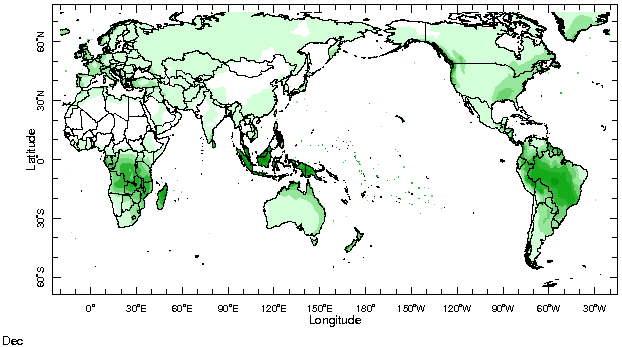|
IRI Climate Digest
January 2002
December Global Climate Summary
Climatological Background
In December, the Northern Hemisphere enters the heart of winter, with strong north-south temperature differences driving the mid-latitude jet stream and storm systems. In the Southern Hemisphere summer is under way, with monsoon systems gaining strength in South America, southern Africa, and Australia.
Monthly Mean Temperature (1961-1990), data from the Climate Research
Unit, University of East Anglia


Monthly Mean Precipitation (1961-1990), data from the Climate Research
Unit, University of East Anglia


Temperatures
Unusually cold conditions gripped nearly all of Europe, while unusually warm temperatures continued to prevail over much of North America. Western Australia remained cooler than average.
Asia: Western China, Siberia and Kazakhstan experienced cold conditions, while Southwest Asia has experienced several consecutive months of unusally warm conditions.
North America: Near-record warm temperatures occured over the eastern and central regions of Canada and the U.S. Several states in the Northeast ranked the warmest October-December in 107 years.
South America: Equatorial South America and areas of Brazil continued their third month of warmer-than-average conditions.
West Africa: Continuing the trend of past months, unusally warm temperatures extended along the Guinea coast countries north along the west coast of Africa into Mauritania.
Europe: Much of central and eastern Europe, including Russia, Poland and Turkey, was gripped by extreme cold.
Australia: The western and southern regions of Australia remained colder than average.
Temperature Difference from the 1961-1990 mean, with data
from NCEP Climate Prediction Center, CAMS.


Precipitation
Drought continued in Southwest Asia, with dry conditions in East Africa. Wet conditions developed in Mozambique and Zimbabwe, as well as southeastern Brazil.
Central America and Caribbean: Persistent drier than average conditions returned to Honduras and northern Mexico.
South America: Drier than average conditions brought some relief to the inundated Pampas in Argentina. The unusually dry conditions in Colombia were broken by above average rains, and southeastern Brazil experienced extremely heavy rains in December.
North America: Unusually dry conditions persisted along the east coast of the United States with Maine, Connecticut, New Jersey, Maryland and South Carolina experiencing the driest October-December season on record. Pacific storms brought above average precipitation to the western US and helped to ease prior drought conditions in the Pacific Northwest. Southern Alaska continued to be unusually dry.
Africa: Abnormally dry conditions were found across Tanzania, Kenya and Uganda, and to a lesser extent along the western equatorial coast of Africa from Equatorial Guinea to northern Angola. It was unusually wet in Mozambique and Zimbabwe, as well as in Madagascar.
Southwest Asia: Rainfall deficits continued across Afghanistan and northern Pakistan during the peak of the wet season.
Australia and New Zealand: The coastal regions of Queensland and South Wales were dry in December, as was the south island of New Zealand.
Precipitation Difference from 1961-1990 mean, with data
from NCEP Climate Prediction Center, CAMS-OPI.


Oceanic Conditions
Tropics: Sea surface temperatures (SSTs) in the equatorial Pacific continued in the same pattern as the past several months, with slightly above average values across the central and western equatorial Pacific and slightly below average SSTs persisting in the eastern region. Numerical forecast models indicate that mild warming is likely to develop through May with the possibility of EL Niņo conditions emerging this boreal summer.
The tropical Indian Ocean is again warmer than average, as is the northern tropical Atlantic Ocean.
Mid latitudes: Above average SSTs continued to persist over much of the northern oceans, although slighty weakened from previous months. In the southern midlatitude oceans, surface temperatures increased in all oceans.
Monthly Sea Surface Temperature Difference from the 1950-1979 mean,
with data from the Environmental Modeling Center, NCEP/NOAA.


Contents |
Special |
Impacts |
Climate |
Forecast
|

